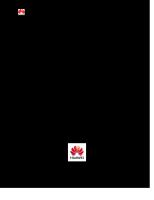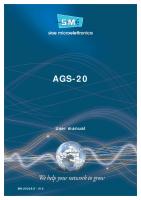1a. T24 Limit - Parameter V1.0 [PDF]
T24 LIMIT Parameters Objectives After completing this learning unit, you will be able to Set up parameters and
50 0 594KB
Papiere empfehlen
![1a. T24 Limit - Parameter V1.0 [PDF]](https://vdoc.tips/img/200x200/1a-t24-limit-parameter-v10.jpg)
- Author / Uploaded
- gasay sinhto
Datei wird geladen, bitte warten...
Zitiervorschau
T24 LIMIT Parameters
Objectives
After completing this learning unit, you will be able to
Set up parameters and related tables Understand the Limit build sequence
Slide 2
Limit Menu
Slide 3
Dependencies – Static Tables Related
CURRENCY
ACCOUNT. CLASS
INDUSTRY
LIMITS
COUNTRY
ACCOUNT. PARAMETER CUSTOMER. STATUS
Slide 4
Parameter Tables
LIMITS
LIMIT.REFERENCE
LIMIT.PARAMETER
Slide 5
Limit Levels
Global
Products
Sub-Products
Sub-Products
Level 0
Sub-Products
Sub-Products
Level 1
Sub-Products
Sub-Products
Level 2
Slide 6
Set up Products
Multi level sub-products
Possible to set up to 12 levels Mandatory - Product Optional - Global + Sub product levels 0 to 9
Important to draw inter-relationship and hierarchy by way of a tree diagram first
Limits can be defined only in bottom-up sequencing
Lowest Multi Level Sub Product should be defined first. At each Multi Level you define the Level and Reference Child, if any
Slide 7
LIMIT.REFERENCE
Admin menu/Limit/Create Limit Reference
Slide 8
LIMIT.REFERENCE - ID of Limit Products
Limit products are classified as Global, Product and Sub Products and identified in a particular way through the Ids
TYPE
LENGTH
EXAMPLE
GLOBAL
5–7
10000
PRODUCT
3–4
SUBPRODUCT
3–4
200000
3000000
100
4000
3000
111 137
4013 4034
3080 3091
Slide 9
LIMIT.REFERENCE – Types of Limit Products
FX TB DP IN NULL
Slide 10
LIMIT.REFERENCE – Types of Limit Products
FX
Foreign exchange limit types, usually include Clean risk to stipulate maximum value of contracts that may mature on any single delivery date. (a.k.a. Delivery risk)
TB
Time band Limits can be set for time periods to control exposure by period for LD, MM, SC etc. ‘Longer the duration, higher the risk’ concept. Automatically apportioned from longer term to short
DP
Deposit type mainly used in LD and MM for information purpose
IN
Information purpose.
Will not trigger any overrides unless CHECK.LIMIT flag is set to Yes in Limit record
Null
Left blank for Account and Global limits All related Limit Products and Sub Products should have the same attribute in this field Slide 11
LIMIT.REFERENCE – Reducing Limit
REDUCING.LIMIT field
Indicates whether the Limit regains its original value on liquidation or repayment of utilisation / draw down.
Options are Y – Reducing or Non – revolving in nature.
N – Non reducing or Revolving in nature
Account, Forex and Money market products can only be defined as Non reducing or Revolving in nature
All products falling under a Global line and all sub products under a Global line will all have to have the same value in this field.
DEFAULT.CHECK
Specifies whether the Limit Reference requires checking, and whether limit overrides are required, when Limit records are created by default For Limits which record data for information only (such as deposits and Fiduciary Placements), this field should be set to 'NO' to prevent overrides being generated
Slide 12
LIMIT.REFERENCE – Limit Sub allocation
500 Loans
High risk
300 Overdrafts Medium risk
400 LCs
Low risk
Slide 13
LIMIT.REFERENCE – Limit Percentage
LIMIT.PERCENTAGE field
Defines the percentage amount of each transaction movement that is to be monitored against the limit amount. This is a flat percentage applied to all contracts under the limit type – If 10% is indicated, for a contract value of 100,000 limit of only 10,000 will be updated To be defined only at the lowest level. – No input allowed for Global limit references and for Products / Sub products with a reference child Always taken as 100% for overdrafts in accounts
The percentage value could be changed through LIMIT.CHANGE
Slide 14
LIMIT.REFERENCE – Rate Mechanism
CONVERT.RATE field
Specifies the rate mechanism to be used for revaluation of limit outstanding when the limit and the transaction are in different currencies When Update.Rate field in LIMIT.PARAMETER is set to No, the mid rate will be uniformly used for revaluation When set to Yes, Options given here will be applied for the respective Limit products. – BUY-BUY, BUY-MID, BUY-SEL, MID-BUY, MID-MID, MID-SEL, SEL-BUY, SEL-MID, SEL-SEL » Home currency USD. Contract currency GBP. Limit currency EUR.
» Under BUY-BUY, GBP will be converted into USD at Buy rate and USD to EUR at BUY rate. » Under SEL-BUY, GBP will be converted into USD at Sell rate and USD to EUR at Buy rate – However in a Limit structure the rate specified in the lowest limit reference used will be taken for updating the outstanding in the higher limits in the hierarchy
Slide 15
LIMIT.REFERENCE – Rate Mechanism Case - 1 Limit XXXXXX.400.01 is in LCY (Say USD). A contract forUSD100000 is put through to hit the limit. In this case since both limit and the transactions are in LCY there is no conversion involved and therefore the limit outstanding will be updated with -100000
Case - 2 A contract for GBP100000 is put through to hit the limit given in case1. Here the transaction in GBP will be converted to LCY which is also the limit currency, using the first component of the CONVERT. RATE specified in the limit reference 400 which in this case is the BUY rate of the transaction currency. If the Buy rate for GBP is 1.50 then the limit outstanding will be up dated by-150000(100000*1.50) and the total outstanding in the limit after this transaction will be 100000-150000= -250000.
Case - 3 Limit YYYYYY.400.01 is in EUR. A contract for GBP100000 is put through to hit this limit. BUY rate of GBP=1.50 Sell rate of EUR=1.20. In this case the transaction in GBP will be converted to USD by using the first component of the CONVERT. RATE which is BUY. This amount will be converted t o EUR which is the limit currency, using the second component of the CONVERT. RATE which is SEL. So the limit outstanding will be calculated using the formula 100000*1.50/1.20=125000(EUR) Slide 16
Workshop
Define the following Limit Structure
Global
Revolving Limit
Non Reducing, ID XXX0000
Product
Loans
Non Reducing, ID XX00
Sub product
Project loan
ID XX01
Study Loan
ID XX02
Slide 17
Workshop - Solution
Global XXX0000 30000
Guarantee
Loans XX00 1700
Project loan
Study Loan
XX01
XX02
1701
1702
Slide 18
LIMIT.PARAMETER
Admin menu\Limit\Update Limit Parameter
Slide 19
LIMIT.PARAMETER – Monitoring and Reporting PARAMETERISATION
Can produce reports before stipulated days of expiry and review dates
1 to 99 days possible
Date and cycle for Country, Commodity and Currency reports
Daily, Weekly, TWMTH and Monthly frequencies possible
Possible to report under suitable groupings of Commodities, Countries and Currency defined in fields
COM.GROUP.GRP and COM.PROD.NO LCs (Group) and Sight and Acceptance L/Cs (Products)
COU.PRODUCT.GRP and COU.PROD.NO CCY.PRODUCT.GRP and CCY.PROD.NO
Also possible to set limits for such groups in LIMIT.COUNTRY, LIMIT.COMMODITY and LIMIT.CURRENCY
Slide 20
LIMIT.PARAMETER – Revaluation Related
Limits in foreign currencies are revalued from time to time as set in REVALUTION.TIME field
Date of first revaluation and further frequency
Whether the revaluation is at mid-rate or a combination of rates like BUY-BUY, BUY-SELL, SELL-BUY etc. Indicated through UPDATE.RATE field
NO indicates that the limit should be revalue at mid rate YES indicates that the rate mechanism choice to be take from CONVERT.RATE field specified in LIMIT.REFERENCE
Slide 21
LIMIT.PARAMETER – Default Limits
Slide 22
LIMIT.PARAMETER – Respective application to products PARAMETERISATION
The product number will be attached to the respective application. If the user desires more specific limit verifications, then he can attach the product number to specific application and category.
Application Product ID Decision Field Decision Decision From Decision To
Slide 23
Limit Build Sequence
LIMITS
LIMIT.REFERENCE
LIMIT.PARAMETER
Slide 24
Workshop - 2
Link the Limit references created in the previous workshop to Loan products of LOANS.AND. DEPOSITS application in LIMIT.PARAMETER.
Slide 25
LIMIT.CURRENCY PARAMETERISATION
Defines Limits by Currency. Maintained on-line, but the System does not attempt to provide realtime information about Currency Limit utilization.
Produced by system default, if not defined earlier and gets updated with subsequent inputs.
Report showing all of the Currency Limits and the use made of each is produced, at EOD process,
Frequency defined on the LIMIT.PARAMETER table.
Slide 26
LIMIT.COMMODITY.GRP PARAMETERISATION
Allows definitions for commodities /industry groupings
System will keep track of outstanding for the grouping, by means of overnight reporting.
It is possible to define any group of Industries as a Commodity Group.
When set up, file LIMIT.COMMODITY can be used to define Limits for Commodity Groups as well as for individual Commodities.
Slide 27
LIMIT.COMMODITY PARAMETERISATION
Defines Limits by Commodity (Industry) Type. File is maintained on-line but no real time information on utilisation.. Report showing all Commodity Limits and the corresponding utilisation is produced at a frequency as defined on the LIMIT.PARAMETER table, as an EOD process. If it is necessary to define Limits for a group of commodities, then the Commodity grouping is specified by the LIMIT.COMMODITY.GRP table.
Slide 28
LIMIT.COUNTRY PARAMETERISATION
Defines Limits by Country or Group of Countries.
No real-time information of Limit utilisation. Report on Country Limits and the utilisation
is produced at a frequency as defined on the LIMIT.PARAMETER table.
If it is necessary to define Limits for a Group of Countries, such as the EEC or South America, then the Country Grouping is specified
by
the
LIMIT.COUNTRY.GRP
table.
Slide 29
LIMIT.COUNTRY.GRP PARAMETERISATION
Allows the definition of Country Groupings.
Overnight reporting.
The file LIMIT.COUNTRY can then be used to define Limits for Country Groups as well as for individual Countries. No logical grouping restriction Possible to define South Africa, for instance, as part of Europe.
Slide 30
T24 Limit: Parameters – A review
In this learning unit, you learnt about Limit Parameter
You will now be able to:
Explain the dependencies of Limit module with other application Understand the limit build sequence
Parameterization of LIMITs
Slide 31
Questions ?
Slide 32
Thank You









